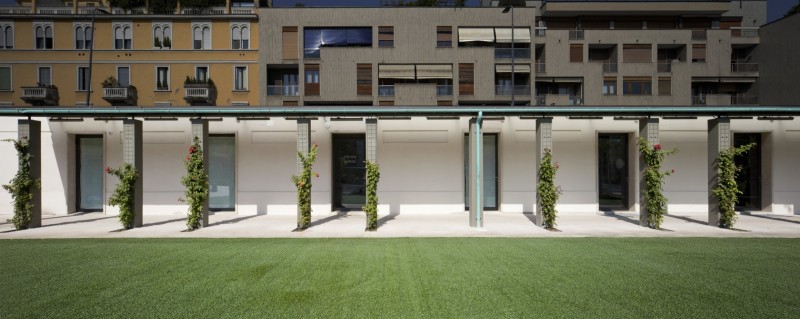Text by: Alessandro Benetti
The history of humanity and architecture also includes a deeply-rooted mythology of the walled-up boundary, which ranges from the immeasurable lengths of the Great Wall of China – the “sole man-made structure visible from space”, according to a false legend – to the symbolic density of the Berlin Wall – a thin and tormented strip of land whose upheavals embodied decades of European history. In 2016, walls are fashionable again, sponsored (with no such wit) by many conservative governments, clumsily trying to interfere with the exorbitant migrations of our age.
Still, the myth of the wall, reading the border as a bi-dimensional separation line, is counterbalanced by a more optimist and curious interpretation, which acknowledges its thickness and stresses out the potential of its intermediate condition, thus interpreting it as a surface available to the project. Hence, fringes turn into the Thirdspace pictured in the mid-Nineties by the post-modern geographer Edward J. Soja, where “a continuous movement beyond dualisms and toward “an-Other” (…)” is produced, “enabling the contestation and re-negotiation of boundaries and cultural identity”. In the same edge spaces blossoms the Tiers Paysage which the French landscape designer Gilles Clément describes as a much-needed “biological shelter (…) and a place of invention for biodiversity”.
But what does building a border mean nowadays? Through the 19th and 20th Centuries, European cities where stripped off their ancient walls, once marking a bold limit between the built fabric and the countryside. As their urban outskirts were sprawling, though, the city cores were progressively losing compactness and unravelling. New marginal third landscapes were spreading through their material structures, bound to an untimely planned obsolesce by the precepts of capitalism.
This twilight zone of internal borders, derelict spaces and leftovers allows contemporary architecture and urban design to re-think our cities from the inside: far from the rhetoric of big real estate operations and removed from the field of global competitions (the tallest skyscraper, the longest bridge, the most intrepid shape and the greenest of all green façades), here designers can aim to respond sensibly to the specific needs of each context.
In Milano, the one-of-a-kind space of the most central of the city’s public swimming pools laid hidden by a featureless fence for more than a decade. The elegant, smooth-edged basins of the Caimi Pool Center, designed by Luigi Lorenzo Secchi back in the Thirties and gently decorated in the whimsical yet sober style of “Novecentismo”, where reduced to ghostly voids, only visible from the inside of the adjacent Teatro Franco Parenti. Andrée Ruth Shammah, an entrepreneur and the director of the theatre, and Michele De Lucchi, an architect and designer, worked on the edge of their disciplines to restore the whole complex and re-open it to the public, coordinating a team including Giovanna Latis, Elena Martucci and Nicola Russi. Today, the former Caimi pools are celebrated as the Bagni Misteriosi, a not-to-be-missed address for the hedonist and radical-chic Milanese summertime. Here, the division between theatre and swimming-pool fades, the rituals and aesthetics of actors and bathers crossover and four moving stages glide on the water to create ever new sets and spaces. The Caimi, once a backyard and a no-man’s land are now a beloved location for the life of the city.

No matter if in late 2016 an uncommonly mild-mannered Trump declared that he would open “one very big, very beautiful door” through the Mexican frontier wall, to welcome all those who pass through it legally. Contemporary architecture has not much to do with building doors and portals, its actual challenge dealing more with designing complex, three-dimensional borders, which can be real spaces for life and not just abstract lines to cross.


